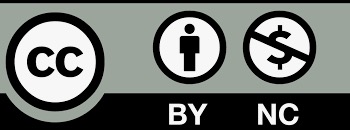Published
2024-11-29
Section
Research Articles
License
Copyright (c) 2024 Sohan Prasad Pradhanang, Rosnah Ismail

This work is licensed under a Creative Commons Attribution-NonCommercial 4.0 International License.
The journal adopts the Attribution-NonCommercial 4.0 International (CC BY-NC 4.0), which means that anyone can reuse and redistribute the materials for non-commercial purposes as long as you follow the license terms and the original source is properly cited.
Author(s) shall retain the copyright of their work and grant the Journal/Publisher rights for the first publication with the work concurrently licensed since 2023 Vol.8 No.2.
Under this license, author(s) will allow third parties to download, reuse, reprint, modify, distribute and/or copy the content under the condition that the authors are given credit. No permission is required from the authors or the publisher.
This broad license intends to facilitate free access, as well as the unrestricted use of original works of all types. This ensures that the published work is freely and openly available in perpetuity.
By providing open access, the following benefits are brought about:
- Higher Visibility, Availability and Citations-free and unlimited accessibility of the publication over the internet without any restrictions increases citation of the article.
- Ease of search-publications are easily searchable in search engines and indexing databases.
- Rapid Publication – accepted papers are immediately published online.
- Available for free download immediately after publication at https://esp.as-pub.com/index.php/ESP

Copyright Statement
1.The authors certify that the submitted manuscripts are original works, do not infringe the rights of others, are free from academic misconduct and confidentiality issues, and that there are no disputes over the authorship scheme of the collaborative articles. In case of infringement, academic misconduct and confidentiality issues, as well as disputes over the authorship scheme, all responsibilities will be borne by the authors.
2. The author agrees to grant the Editorial Office of Environment and Social Psychology a licence to use the reproduction right, distribution right, information network dissemination right, performance right, translation right, and compilation right of the submitted manuscript, including the work as a whole, as well as the diagrams, tables, abstracts, and any other parts that can be extracted from the work and used in accordance with the characteristics of the journal. The Editorial Board of Environment and Social Psychology has the right to use and sub-licence the above mentioned works for wide dissemination in print, electronic and online versions, and, in accordance with the characteristics of the periodical, for the period of legal protection of the property right of the copyright in the work, and for the territorial scope of the work throughout the world.
3. The authors are entitled to the copyright of their works under the relevant laws of Singapore, provided that they do not exercise their rights in a manner prejudicial to the interests of the Journal.
About Licence
Environment and Social Psychology is an open access journal and all published work is available under the Creative Commons Licence, Authors shall retain copyright of their work and grant the journal/publisher the right of first publication, and their work shall be licensed under the Attribution-NonCommercial 4.0 International (CC BY-NC 4.0).
Under this licence, the author grants permission to third parties to download, reuse, reprint, modify, distribute and/or copy the content with attribution to the author. No permission from the author or publisher is required.
This broad licence is intended to facilitate free access to and unrestricted use of original works of all kinds. This ensures that published works remain free and accessible in perpetuity. Submitted manuscripts, once accepted, are immediately available to the public and permanently accessible free of charge on the journal’s official website (https://esp.as-pub.com/index.php/ESP). Allowing users to read, download, copy, print, search for or link to the full text of the article, or use it for other legal purposes. However, the use of the work must retain the author's signature, be limited to non-commercial purposes, and not be interpretative.
Click to download <Agreement on the Licence for the Use of Copyright on Environmental and Social Psychology>.
How to Cite
Perceived biopsychosocial determinants of psychotic illness among caregivers impacts on the family of Kathmandu district in Nepal
Sohan Prasad Pradhanang
Faculty of Psychology and Social Sciences, University of Cyberjaya, 63000, Malaysia
Rosnah Ismail
Faculty of Psychology and Social Sciences, University of Cyberjaya, 63000, Malaysia
DOI: https://doi.org/10.59429/esp.v9i11.2952
Keywords: psychotic, patients, emotional determinants, impacts
Abstract
The aim of the study is to determine whether the biological, psychological, and social components contributing to psychotic illness and examine their effects on families across social, financial, emotional, and health dimensions. A Population Proportion Formula was used to determine the sample size, applying a theoretical approach to a sample of approximately 200 caregivers of psychotic patients in Kathmandu, Nepal. Quantitative data were gathered via questionnaires. Nonclinical data were used for analysis. Findings from the analysis of Objective 1 revealed that social determinants were most reported; however, biological and psychosocial factors were also prevalent. These determinants were both directly and indirectly linked to psychological or emotional factors, aligning with the biopsychosocial (BPS) model developed by George Libman Engel of the University of Rochester Medical Center, New York. The biopsychosocial (BPS) model was formulated in the mid-1970s, with significant discussion of the model occurring in a seminal article published in 1977 in the journal Science. For Objective 2, results showed that the emotional impact on families was the most prominent, followed by social, financial, and health impacts. The findings show that emotional effects have the greatest influence, followed by financial, social, and health effects. These results reinforce the need for further research into the factors associated with psychotic disorders and their effects on families.
References
[1]. American Psychiatric Association, 2024. Chapter "Schizophrenia Spectrum and Other Psychotic Disorders" Diagnostic and Statistical Manual of Mental Disorders 2024; Volume Revision, Pages 87-122. doi https://doi.org/10.4135/9781412964500.n104
[2]. American Psychiatric Association, 2024. Chapter "Schizophrenia Spectrum and Other Psychotic Disorders" Diagnostic and Statistical Manual of Mental Disorders 2024; Volume Revision, Pages 87-122. doi https://doi.org/10.4135/9781412964500.n104
[3]. Marthoenis M., 2 Aichberger, M. C., and 3 Schouler-ocak, M., 2016. Patterns and determinants of treatment seeking among previously untreated psychotic patient.Hindawi Scientifica 2016; Volume 2016, Article ID 9136079, s 2016 Page 1–7.https://doi.org/10.1155/2016/9136079
[4]. Early Assessment and Support Alliance. 2016. Impact of Psychosis on Family Members URL https://easacommunity.org/impact-of-psychosis-on-family-members.php Retrieved August 31, 2021
[5]. Lippi, G., 2016. Schizophrenia in a member of the family: Burden, expressed emotion and addressing the needs of the whole family. South African Journal of Psychiatry, 2016; Volume22 (1), Page 1–7. https://doi.org/10.4102/sajpsychiatry.v22i1.922
[6]. Nepal Health Research Council.,2020. National Mental Health Survey 2020 Fact Sheet; Fact Sheet website: https://publichealthupdate.com/wp-content/uploads/2020/09/Screen-Shot-2020-09-22-at-08.54.14.png Retrieved July 15, 2021, from National Mental Health Survey 2020 Fact Sheet website
[7]. Nepal Health Research Council.,2020. National Mental Health Survey 2020 Fact Sheet;. Fact Sheet website: https://publichealthupdate.com/wp-content/uploads/2020/09/Screen-Shot-2020-09-22-at-08.54.14.png Retrieved July 15, 2021, from National Mental Health Survey 2020 Fact Sheet website
[8]. Central Bureau of Statistics (CBS) National Statistics Office, National Population and Housing Census 2021 (National Report), 2022, Reprint: May 2023; Supported by the United Nations Population Fund (UNFPA), Nepal. Page 614 Volume 01.Website: www.cbs.gov.np, Retrieved December 15, 2025,
[9]. Central Bureau of Statistics (CBS) National Statistics Office, National Population and Housing Census 2021 (National Report), 2022, Reprint: May 2023; Supported by the United Nations Population Fund (UNFPA), Nepal. Page 614 Volume 01.Website: www.cbs.gov.np, Retrieved December 15, 2025
[10]. Nepal Health Research Council.,2020. National Mental Health Survey 2020 Fact Sheet; Fact Sheet website: https://publichealthupdate.com/wp-content/uploads/2020/09/Screen-Shot-2020-09-22-at-08.54.14.png Retrieved July 15, 2021, from National Mental Health Survey 2020 Fact Sheet website
[11]. Nepal Health Research Council.,2020. National Mental Health Survey 2020 Fact Sheet; Fact Sheet website: https://publichealthupdate.com/wp-content/uploads/2020/09/Screen-Shot-2020-09-22-at-08.54.14.png Retrieved July 15, 2021, from National Mental Health Survey 2020 Fact Sheet website
[12]. Nepal Health Research Council.,2020. National Mental Health Survey 2020 Fact Sheet;. Fact Sheet website: https://publichealthupdate.com/wp-content/uploads/2020/09/Screen-Shot-2020-09-22-at-08.54.14.png Retrieved July 15, 2021, from National Mental Health Survey 2020 Fact Sheet website
[13]. World Health Organization, 2024. WHO Special Initiative for Mental Health. WHO, 2 Key achievements in 2021-2022; Website: https://www.who.int/initiatives/who-special-initiative-for-mental-health/nepal, Retrieved September 15, 2024,
[14]. Prakash Sharan Mahat, finance minister of Nepal, Goverment of Nepa,l Ministry of Finance, 2022. Budget Speech of Fiscal Year 2022-202; 3rd June 29, 2022; Location: Parliament of Nepal, Kathmandu, Nepal
[15]. Akbari, M., Alavi, 2 M., Irajpour, A., and 3 Maghsoudi J., 2018. Challenges of family caregivers of patients with mental disorders in Iran: A narrative review. Iranian Journal of Nursing and Midwifery Research, 2018; Volume 23(5), Page 329–337. https://doi.org/10.4103/ijnmr.IJNMR_122_17
[16]. Dowling, A. S. 2005,. “George Engel, M.D. (1913–1999)”. American Journal of Psychiatry, 2005; Volume 162 Number(11), 2039–2039.https://doi.org/10.1176/appi.ajp.162.11.2039
[17]. Abera, M., Robbins, 2 J. M., 3 Tesfaye, M., 2015. Parents’ perception of child and adolescent mental health problems and their choice of treatment option in southwest Ethiopia. Child and Adolescent Psychiatry and Mental Health 2015; Volume 9(1), Page 1–11.https://doi.org/10.1186/s13034-015-0072-5
[18]. Mercedes Gonzalez-Sanmamed, 2. Pablo-César Muñoz-Carril, and 3.Francisco-José Santos-Camano, 2019 Key components of learning ecologies: A Delphi assessment. British Journal of Educational Technology 2019; Volume50, Issue 4 July 2019 Pages 1639-1655 https://doi.org/10.1111/bjet.12805
[19]. Jan Olav Johannessen, and 2 Inge Joa, 2021. Modern understanding of psychosis: from brain disease to stress disorder. And some other important aspects of psychosis. ResearchGate,, 2021; Volume 13(4), Page 289–301. https://doi.org/10.1080/17522439.2021.1985162
[20]. Nick Dauchot,. 2018. Systems Theory for Designers.Medium (Journal) Web site: https://medium.com/@nickuxd/finality-constructs-in-design-systems-466ae4c2c06c Retrived24 th April, 2023
[21]. Delisi, M. (2014). Equifinality, Multifocality, and immorality in a life of crime. International Journal of Offender Therapy and Comparative Criminology 2014; Volume 58(3), Page 263–264.https://doi.org/10.1177/0306624X13512787
[22]. Central Bureau of Statistics (CBS) National Statistics Office, National Population and Housing Census 2021 (National Report), 2022, Reprint: May 2023; Supported by the United Nations Population Fund (UNFPA), Nepal. Page 614 Volume 01.Website: www.cbs.gov.np, Retrieved December 15, 2025
[23]. Central Bureau of Statistics (CBS) National Statistics Office, National Population and Housing Census 2021 (National Report), 2022, Reprint: May 2023; Supported by the United Nations Population Fund (UNFPA), Nepal.Page 614 Volume 01.Website: www.cbs.gov.np, Retrieved December 15, 2025
[24]. Dowling, A.S., 2005. Psychiatry Online Images in psychiatry: George Engel, 1913-1999, 2005; Web Site http://ajp.psychiatryonline.org/cgi/re- print/162/11/2039 Retrieved 28th, March 2023.
[25]. Abera, M., Robbins, J. M., and 2 Tesfaye, M. (2015). Parents’ perception of child and adolescent mental health problems and their choice of treatment option in southwest Ethiopia 2015;. Child and Adolescent Psychiatry and Mental Health, Volume 9(1) Page, 1–11. https://doi.org/10.1186/s13034-015-0072-5
[26]. DOLAN, R. J, 2002. National Library Medicine, PubMed 2002; Emotion, Cognition, and Behavior _ Science. Volume 298,(Issue 5596), Page 1191–1194.https://doi.org/DOI: 10.1126/science.1076358
[27]. Nick Dauchot,. 2018. Systems Theory for Designers.Medium (Journal) Web site: https://medium.com/@nickuxd/finality-constructs-in-design-systems-466ae4c2c06c Retrived24 th April, 2023







